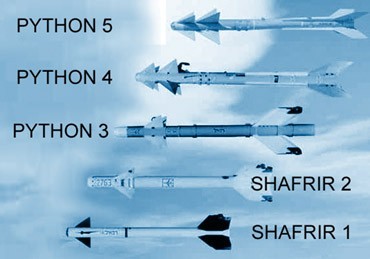
Israel Weapons include Shafrir and Python
Following is information regarding the weapons that Israel uses at war, especially during its attacks on Lebanon.
The first two generations of weapons were the Shafrir 1 introduced in 1964, and the Shafrir 2 made in 1968. Both these weapons have a performance which is similar to the American AIM-9. They are both a benchmark in heat seeking air to air missiles industry. These two missiles were made in Israel.
Shafrir 1 missile was considered as a first attempt by Israel to develop a world recognized missile and It was recongnized as an entry ticket for the world's missile industry.
Shafrir 2 had an big success since it had shot down almost 100 aircrafts during the Yom Kippur War in 1973.
Python 3, the third generation of Rafael's air to air missiles had created a real revolution in the IAF's air combat capabilities. It entered into service in 1978, this missile was considered as the American Sidewinder top model.
While the Shafrir missiles was limited to rear sector, it was a fact that the Python 3 could enabled the pilot to fire at different angles which was considered not possible during that time. Hence, the Python 3 had changed forever the way air combats were taught and done in the IAF.
During and before its War on Lebanon in 1982, Israel had used the Python 3 and credited to 35 killings of aircrafts.
In 1996, this missile obtained an improved version, which offered better performance, and soon got itself a note as being The best air to air missile in the world.
Python 3 showed a big achievement in missile development, as engineers started working and developing a next generation, The Python 4.
An outstanding feature of Python 4 was its ability to enable the pilot to shoot at any target in the front hemisphere of the aircraft, not matter what its relative position was. Python4 had an integrated helmet sight, designed by Elbit Systems to enable the pilot to shoot at whatever he sees in the helmet.
As soon as an enemy aircraft falls into that front hemisphere, the pilot can capture the target with its eyes. Then the missile head seek control would locks onto the target, and can shoot down. As easy as; See it, Shoot it.
Python4 also gives pilots a tactical advantage over its counters as it frees them from navigating to a hard firing position.
Hence using this weapon, a bombs loaded aircraft does not have to release its munitions in case of an air combat, or drop its fuel tanks in order to maintain air control. This has major strategic power including greater chances to complete its mission, by reducing the number of escort targets.
Even Today, the performance of the Python 4 is still unique. Today there are a number of missile models which have been developed in United States and Europe which are supposed to equal their performance to the Python 4 missile. However, Python 4 is operational since 10 years now, and still holds Superior IAF Quality Performance
During the early 2000, Engineers in Israel were already designing and developing the next best weapon, The Python 5.
With Todays Technolody and Computer Power, this missile really does the impossible by enabling a 360x360 degree sphere launch and shoot capabilities.
The pilot can shoot down any plane, at any angle. Even targets which are behind the launching aircraft. Python 5 is the world first air to air missile that can fire backwards and in all directions.
Dan Rozen, a weapon engineer, who was involved in the development of all 5 generations of the Shafrir and Python air to air missiles. He was trying to develop a weapon that can be so easy to use. using this weapon all what the pilot has to do is press a button and shoot, and this is what the Python 5 can achieve today.
The Python 5 gives the pilot an endless flexibility. Using this weapon even unexperienced pilots, who are still at school, can be put on an aircraft and be driven to war.



